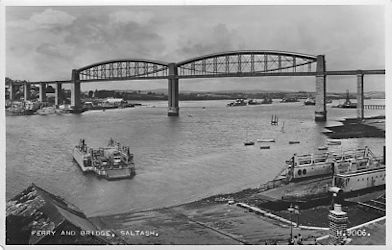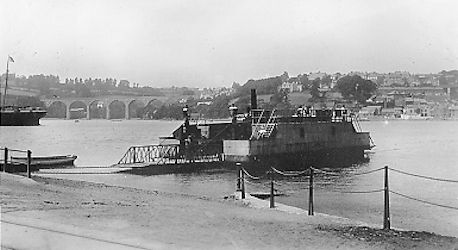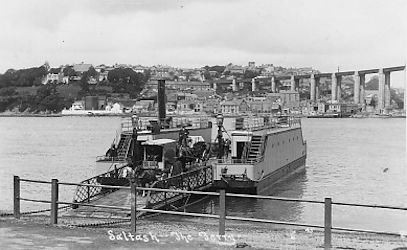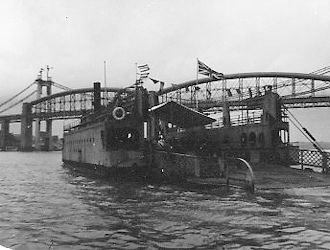|
OLD DEVONPORT
. UK |
||
|
© Brian
Moseley, Plymouth Webpage created: March 16, 2016 Webpage updated: November 21, 2022 |
||
|
- SALTASH FERRY (FLOATING BRIDGE)
The Saltash Ferry approaching Saltash Passage,
Saint Budeaux. From around the time of the Norman Conquest until 1270 the rights for the ferry from Saltash Passage on the Plymouth side of the river Tamar to Saltash belonged to the Valletort family. When Roger de Valletort sold Trematon Castle and Manor to Richard Earl of Cornwall, the rent was paid to the Earl’s bailiff. This amounted to £6 18s in the 1290s. The Burgesses of Saltash leased the ferry from the Duchy of Cornwall from 1337 onwards for £10 a year. The Duchy provided the boat. They continued to hold the lease except for one year, 1356-57, when the Black Prince leased it to his military porter, William Lenche, in recognition of his services at Poitiers. In 1385 the rights were granted to the Mayor and Burgesses of Saltash for 200 years. Rent was always payable to the Duchy of Cornwall although in 1585, 1678, 1683 ad 1774 Queen Elizabeth granted the ‘benefits of passage’. By 1618 the rent was £20 per year.
Saltash Floating Bridge number 4 at Saltash Passage. On May 29th 1733 the ferry overturned and sank with the loss of 20 lives. In 1764 the ferry fares were advertised in the “Sherborne Mercury” as 7 shillings 6 pence for a coach and six horses, 5 shillings for a carriage and four; 2 shillins 6 pence for a carriage and pair; 1 shillings 3 pence for one-horse chair. In 1772 the rent was £223. In 1804 the rent for working the old horse boat was £360 per annum. In 1832 the Earl of Morley, Mr A Edgcumbe, Sir William Molesworth and Others secured an Act of Parliament so they could purchase ferry rights for about £5,000 and establish a steam-powered floating bridge. The Saltash Floating Bridge Act 1832 received the Royal Assent on March 24th 1832. Floating Bridge Number 1 was launched in 1832 but withdrawn in 1834, as a result of which Saltash Corporation claimed the ferry rights back. They put their old horse-boats back in service at the old rates. When a "Special Assembly" was called on Friday May 25th 1838 the names of the directors or preicipal shareholders was stated to be Messrs Edward Archer; John T Coryton; Peter Glubb; J M Rendel (the engineer) ; and Edward Rodd DD. On May 31st 1850 a new lease was granted for 21 years at a rent of £195 per annum to a new company who proposed to reintroduce the steam ferry service. Floating Bridge Number 2 started running in 1851 for four trips every hour. The crossing time was six minutes. It was announced at the opening ceremony that the tolls for the transportation of cattle had been lowered to encourage greater use of the ferry and that it was hoped the Saltash Turnpike Trust would do likewise. Floating Bridge Number 2 served until she sank at her mooring on the Plymouth side during a storm in the winter of 1865-66. Her engines were salvaged and used in a new vessel which the Launceston Weekly News announced on Saturday February 10th 1866 was to be built at a cost of £800: it would be ready in May, they said. Saltash Town Council granted a new lease for twenty-five years and reduced the rental from £195 to £127 per year. Business boomed and dividends of 20 to 30% were being paid to shareholders, as a result of which the citizens of the Town wanted to get the ferry rights back in their own hands. Unfortunately this was not as easy as it seemed and it was only thanks to the Earl of Mount Edgcumbe and Mr Leonard Courtney, Member of Parliament, that the difficulties were removed. The Local Government Board gave permission for £800 that had been paid to Saltash Corporation by the Admiralty in respect of HMS "Defiance" being used to purchase a new ferry bridge. The Saltash Ferry Bridge Company's lease expired on Michaelmas Day, Tuesday September 29th 1891 and the management of the service was returned to Saltash Town Council. A brand new ferry bridge had been ordered to replace the existing one, which had given nearly forty years' service. The new one was expected from Messrs Willoughby Brothers Limited in two weeks time. The Royal Cornwall Gazette revealed on Thursday August 27th 1891 that the new bridge had been launched by at Willoughby's the previous Thursday, August 20th 1891. Floating Bridge Number 4 was installed on its chains during the afternoon of Wednesday December 30th 1891. The Ferry Service was making a good profit for the Borough of Saltash and paid for many improvements in the Town. Number 4 was replaced for a time in 1895 by a barge lashed to one of Mr Reynold's tugs. Messrs Willoughby Brothers at Millbay Docks constructed Floating Bridge Number 5, which entered service after an official ceremony in October 1911. Floating Bridge Number 4 was retained as a spare and moored on the Plymouth side. During the change-over of the two vessels, the service was maintained by the old horse-boat, which was sold in 1913 for £2 10 shillings.
Horses and wagons on the Saltash Ferry at Saltash Passage,
Devonport. On Wednesday September 5th 1917 passage on the Saltash and Torpoint ferries was made free for servicemen and nurses in uniform but not on duty. A new Floating Bridge, Number 6, was purchased in September 1927 and Number 4 was sold for £75. During 1929 the Saltash ferry Service carried 32,402 vehicles. The final Floating Bridge, Number 7, was put into service in December 1933 and Bridge Number 5 was sold, again for £75. In 1935 there was a mishap when Engineman Mr W Gill went astern instead of ahead and stranded the ferry on the Saltash side. In 1942 the first ferry left Saltash at 6.30am and Saltash Passage at 6.45am and ran every half-hour until 11pm from Saltash and 11.15pm from Saint Budeaux. On Sundays, Good Friday and Christmas Day the service started at 7am. During the summer months the ferries started at 6amand 6.30am and operated a 20-minute service between 9am and 8pm. Saltash residents travelled free if on foot. The normal single fares were two pence for a pedestrian, one shillings and sixpence for a car, and ten shillings for a coach. HRH the Princess Elizabeth used the Ferry to in October 1949 while she was on a two-day tour of the Duchy of Cornwall. The ferries were changed over twice a year, at night, and took five hours to complete. During the financial year 1956-57 the Saltash Ferry ran up a loss of £6,613. It was the first year since the Second World War when the income from tolls actually fell. In 1955-56 the tolls had raised £28,182 but in 1956-57 that figure was only £26,970. The annual accounts also revealed that £3,260 had been spent on coal and £8,071 on wages. Total running costs had amounted to £33,304. The ferry tolls were increased for that summer. It is said that on a Saturday in 1957, when Plymouth Argyle Football Club were playing at Home Park, the ferry ran aground on the Saltash side stranding hundreds of Argyle's Cornish supporters on their way to the match until it could be refloated at high tide.
The last day of operation of the Saltash Ferry.
The final crossing was operated by
Floating Bridge Number
6 and ran at 11pm from Saltash and 11.15pm
from Saltash Passage on October 23rd 1961. The
last car on was driven by Mr P Joblin, of Quethiock, a regular on the 11.15pm
service. His was also the last
car off, although many mysteriously broke down hoping to be pushed off last!
A special commemorative trip was from Saltash at 4.30pm on Tuesday October 24th
1961. |
||



